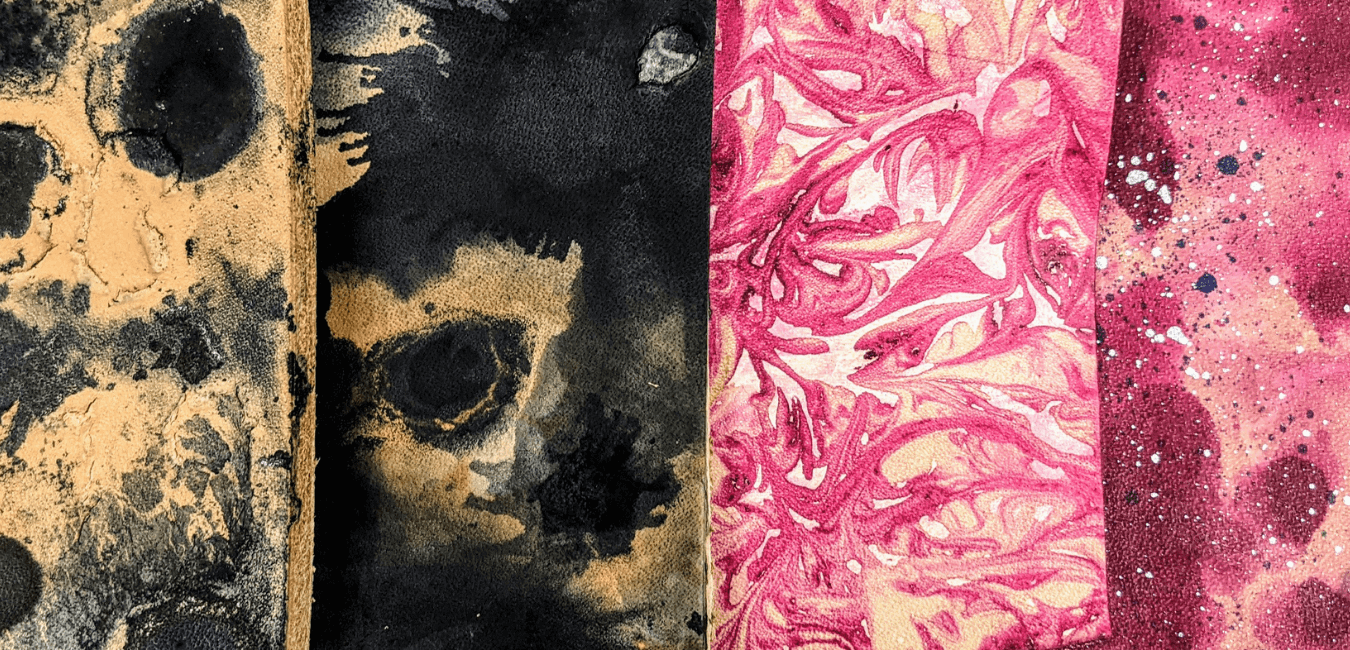Learn How-To Marble Or Tie Dye Leather, Quick & Easy!

Creating unique patterns on leather is incredibly popular right now. And luckily, it’s also incredibly easy to do!
No need to mix your own concoctions or buy any extra supplies like marble paint. These marbling and tie dye techniques can be done using the leather dye you likely already own and a few things you can easily find around the house.
Let’s get started!
Shaving Cream Marbling Effect
You’ve likely seen this technique around. I remember using this trick in gradeschool to make really bright and colorful paper. And honestly, a remarkable amount of interesting paper dyeing techniques will work great for leather, with very few tweaks.

Here’s the supplies you will need:
- Vegetable Tanned Leather. Natural veg tan leather has no dye or finishes applied to it so it is the easiest to use for this as it will pick up the most color.
- Shaving cream. I used cheap, old Barbasol. It has no dyes or moisturizers in it, so it won’t affect the look of the leather or dye. I got mine for only $1.20 at the local store.
- Tin Foil or an Aluminum Roasting Pan. Which one you choose will depend on the size of the leather you are trying to marble. For large pieces, lay out some foil on your work space. For smaller pieces, like I’m using, I chose a disposable roasting pan that I can use over and over.
- Leather Dye. I am using Fiebings Leather Dye for this post. It is an alcohol based dye. Water based dyes may react differently and yield different results from mine, but feel free to test it and let me know!
- Dropper. You can pick these up at craft stores or pharmacies. You may also have some from old cosmetic bottles or medications.
- Skewer or Toothpick. You’ll need something to blend the dye and the shaving cream, so I would suggest something like a skewer. I just used the backend of a paintbrush I had lying around and it worked just fine.
- Gloves. You will be working with dye that can very easily dye your hands, so cover them up or be prepared to look very questionable, depending on which colors of dye you use.
- Paper Towels. You’ll need them to wipe down the leather after dyeing.
To start, lay out your foil or your roasting pan. This can get messy, so make sure you’re somewhere you don’t mind getting dye on or cover your workspace accordingly!

Take your shaving cream, and spray a layer onto your work surface. You don’t need a ton, it will expand as it sits!
Use your hand or a spackle tool to smooth the top layer down. Don’t worry if it is still a little uneven, it does not need to be smooth like cake icing. You just want to get rid of any large air pockets.

Once the shaving cream is smoothed down a bit, take your dropper, and load it up with dye. Start dripping single dots of the dye wherever you want it on top of the shaving cream.
You can make a pattern or drop it around willy nilly. The design is up to you. You can even use two or more colors of dye should you feel so inclined!
Take your skewer, and start to swirl the dye and the shaving cream around. Don’t mix it vigorously. You want the dye to simply swirl around. This will be the pattern that gets transferred onto your leather.
Take your leather, and gently lower it, top side down, onto the shaving cream. Gently press it down into the cream. You want to ensure as much of the leather’s surface is in contact with the dye as possible, or you may end up with random patches.
If you don’t want the color to transfer to the suede side of the leather, be sure not to submerge it completely in the shaving cream.
Let it sit for roughly 30 seconds to one minute. It doesn’t take long for the color to transfer over. After your wait is done, use your skewer to lift up a corner of your leather, and remove it from the dye.

Scrape off the excess cream and dye, then wipe it down with a paper towel to remove the remaining foam.
Take a look at what you made! You should have a swirled, marbled pattern on your leather that is now ready to be turned into any number of projects. Marbling leather is much easier than you thought, right?
You can choose not to seal the leather or use any kind of finish you would typically use on your projects. Since this was done with regular old leather dye, there won’t be any weird reaction, peeling, or color lifting.
Wondering what to do with all that foam left over? You can trash it, or you can use it again for a slightly different effect. If you mix your foam with the leftover dye completely, you’ll end up with a foam that is lightly colored. Use that to get new colors or, spread that flat, then follow all of the above steps again.This time you will end up with leather dyed an overall color, with none of the natural color showing through. This can create a cool ombre effect with the marbling.
Tie Dyed or Watercolor Effect
This effect creates a soft overall color, reminiscent of tie dye. It can also be changed from a tie dyed appearance to more of a runny watercolor look quite easily.

The supply list is shorter for this one:
- Vegetable Tanned Leather. Again, this leather just takes dye the easiest.
- Leather Dye. Regular old Fiebing’s works great for this.
- A Bowl or Tray of Water. Use something you don’t mind getting stained. And honestly, you’re ok with not using it for food or drinking again. I’m using disposable roasting trays again for this.
- Dropper. You can certainly pour dye into the water, but the dropper is more gentle and will allow you to concentrate color easier.
- Gloves. Keep those fingers clean, you will be submerging them in water full of leather dye.
- Paper Towels. You’ll need somewhere for your leather to sit and dry, paper towels work great for this.
To start, make sure your work area is protected from dye and water.

Add about an inch of water to your tray or bowl. Keeping the water shallow gives the dye less space to sink in.
Take your dropper and load it with dye, then start dropping it onto the water’s surface. Do not mix or swirl it. The water will do this on its own. Keep in mind you must work fast here as the dye will start to dilute in the water and you may lose your chance to get a strong color.

Once your dye has been added, take your leather and place the top side down on top of the water. It will float as long as you set it down gently. If you do not want color transfer on the back of the leather, do not submerge it.You do not need to wait very long for this process. Give it a few seconds on the water, then gently lift it out.
You should see a very soft tie dye effect has appeared across the top of the leather. If you want to add another color, you can simply add some more drops to your water and do the whole process over again!

I mentioned above that this could be made to look more like watercolor if you would prefer. After you’ve added this lighter dye pattern as a base, you can use the water on the surface of the leather to add more dynamic color.
When you pull it from the water, you may have noticed that water had beaded or pooled on the leather. Using your dropper of dye, you can add dye to these beads of water and deposit a darker spot of color.
If you want it to look watery or runny, you can simply blow on the wet dye to spread it in whatever direction you choose. You can also use compressed air or an empty air brush if you have one!

Once you’re happy with your patterns, set your leather aside to dry on some paper towels. Once it is completely dry (this will likely take 24+ hours), apply some conditioner to help snap the leather back as it may now be a little stiff and hard to work with from being soaked. It’s now ready to be used for any project you see fit!
Just like with the marbling technique, this is simply dye that has been applied in an unusual way, and can be finished with whatever you typically use, whether resolene, Tan Kote, or just conditioner.
These are great techniques to experiment with. Plus, you’ll always get a unique finish making your pieces truly one of a kind.If you make something using these techniques, tag us on social media so we can see them! Use @theleatherguymn on Facebook or Instagram.Thanks so much for reading along today! Be sure to reach out to us if you have any questions, we’re here to help.

